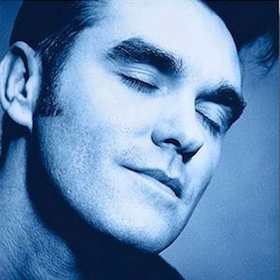'Morrissey': A Stunning Autobiography Exploring The Dark Mind Of The Beloved Musician

4/5
You know Steven Patrick Morrissey best by his surname, Morrissey, the legendary musician and frontman of The Smiths, so it’s fitting that Morrissey should be the eponymous title of his autobiography.
Morrissey’s writing style is lyrical and rhythmic. After a few pages of his prose, it is evident that the author is an immensely talented wordsmith. His sentences feel like they’re on a continuous burn, slowly gaining steam until his position is made clear. His writing flows like freestyle and makes for an immensely enjoyable read.
His writing, much like his personality, is blunt and often dark. His autobiography begins by describing his childhood in Manchester and the schools he attended as a boy.
Morrissey first went to St. Wilfrid’s, a school where the staff “stutters on, minus any understanding of the child mind.” (9)
School was a black hole of relentless abuse for Morrissey and it worsened when he attended St Mary’s Secondary Modern School. There, the headmaster, Vincent Morgan, beat up to 12 boys (whom he picked seemingly at random) every morning at assembly. Eventually, Morrissey was selected, yet he felt more anger that a smaller boy had trouble standing after six whacks, rather than feel mad that he was beaten. Morrissey has an abundance of empathy and it is a primary reason why he considers himself an animal protectionist. (The Smiths second album was titled Meat is Murder.)
Depression plagued Morrissey at an early age and it’s clear to see — after reading about his experience in school — that his teachers and the daily abuse they doled out left him emotionally scarred. As he wrote on page 59, “Each day is Kafka-esque in its nightmare, and the school offers nothing at all except a lifelong awareness of hate as a general truth.”
He concluded that a generation of Manchester kids was irrevocably damaged by the attitude of teachers who did anything but encourage their students.
Did he ever have a realistic chance to be happy after the abuse he endured in school? Morrissey would say no.
“This is the Manchester school system of the 1960s, where sadness is habit-forming, and where same is cattle-prodded into kids who are in pursuit of bliss amid the unrelenting disapproval,” he wrote on page 11.
The abuse he experienced in school impacted every future relationship he’d have and left him with a formidable sense of despair. However, music helped him cope with life and he discussed him musical influences in great detail in Morrissey.
He recalled his first concert, when he saw the glam rock band T. Rex on June 16, 1972. Years later, Morrissey asked Marc Bolan, the lead singer of T. Rex, for his autograph in the lobby of a hotel in Manchester. Bolan said no, disappointing Morrissey, yet again.
The media has speculated about Morrissey’s sexuality for decades and the singer does address the subject in his autobiography, but fails to offer many details.
However, according to an article in The Independent, several passages concerning the singer’s relationship with photographer Jake Walters were left out of the American version of the book.
Morrissey never specifies if he and Walters were lovers, but it is clear they were intimate friends. They met at a restaurant, a badly lit one in Notting Hill, and Morrissey walked out of the restaurant when he saw a “sloppy dish of dog food on [Jake’s] plate.”
After Morrissey returned to his apartment at Regent’s Park Terrace, the doorbell rang. It was Walters.
“He obviously understood my sudden exit, and he had been curious enough to follow me home,” Morrissey wrote of Walters.
“‘Why did you mention Battersea in that song?’ is [Jake’s] opening gambit.
‘Because it rhymed with Fatty,’ I reply with magnanimous Philip Larkin don’t-trouble-me-now-child eminence. Jake pulls down his lower lip with two fingers and the word BATTERSEA I tattooed into the painfully fragile skin inside the mouth.” (274)
In the American release of his autobiography, Morrissey wrote a total of three pages about his relationship with Walters. On the other hand, he detailed the court case former Smiths drummer Mike Joyce filed against Morrissey for more than 30 pages.
One of my favorite anecdotes in the book was when Morrissey was invited to watch a taping of Friends in Los Angeles.
“Friends has become the most popular TV show in the world, showing life as it is commonly lived in America’s carefully preserved unreality. The cast is friendly, and I am immediately taken aside by the scriptwriters and asked if I’d jump in on a newly jumbled plot-line where I appear with the character Phoebe in the Central Perk diner, where I am requested to sing ‘in a really depressing voice’. Within seconds of the proposal, I wind down the fire-escape like a serpent, and it’s goodbye to Hollywood yet again,” he wrote. (364-5)
One of the most compelling sections of Morrissey is when he describes the environment at his concerts and his mental state while he’s touring. His mood fluctuates vastly depending on where he is and whom he’s with. It’s also interesting to read about his reception in England, as he’s convinced that the British media have it in for him (particularly NME, short for New Musical Express) and that they never provide coverage of his sold out shows or play his music on the radio.
Morrissey is a comprehensive look into the world of a man who cherishes his privacy above almost all else. If you have any interest in Morrissey’s musical influences or the origins of the The Smiths split from his perspective, this autobiography is worth your time. If you are hoping to read play-by-play regarding Morrissey losing virginity, you’re out of luck.
You want Morrissey to let you all the way in, so you can experience firsthand the pain that helped him pen those beautiful, haunting song lyrics. He does hold back a bit, but Morrissey is as close as you’ll ever get to learning about the real Steven Patrick Morrissey.
RELATED ARTICLES
Get the most-revealing celebrity conversations with the uInterview podcast!





Leave a comment